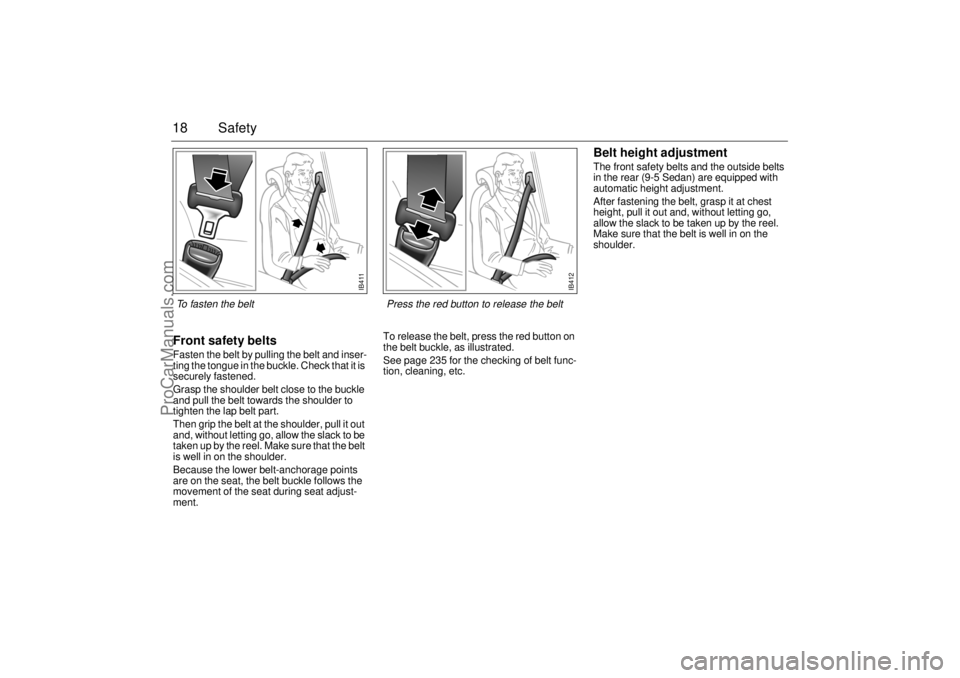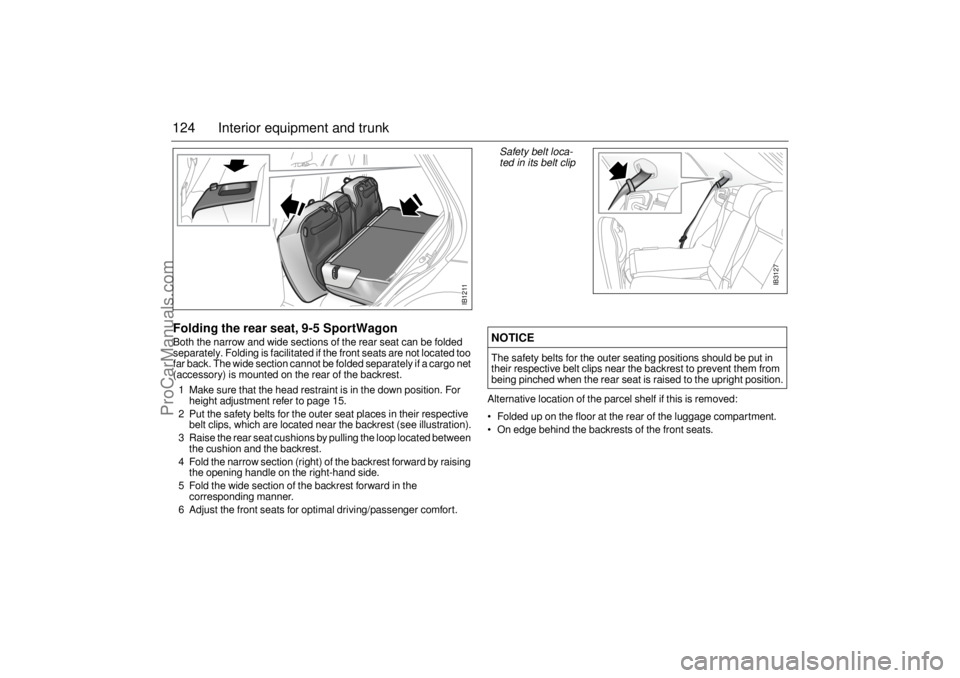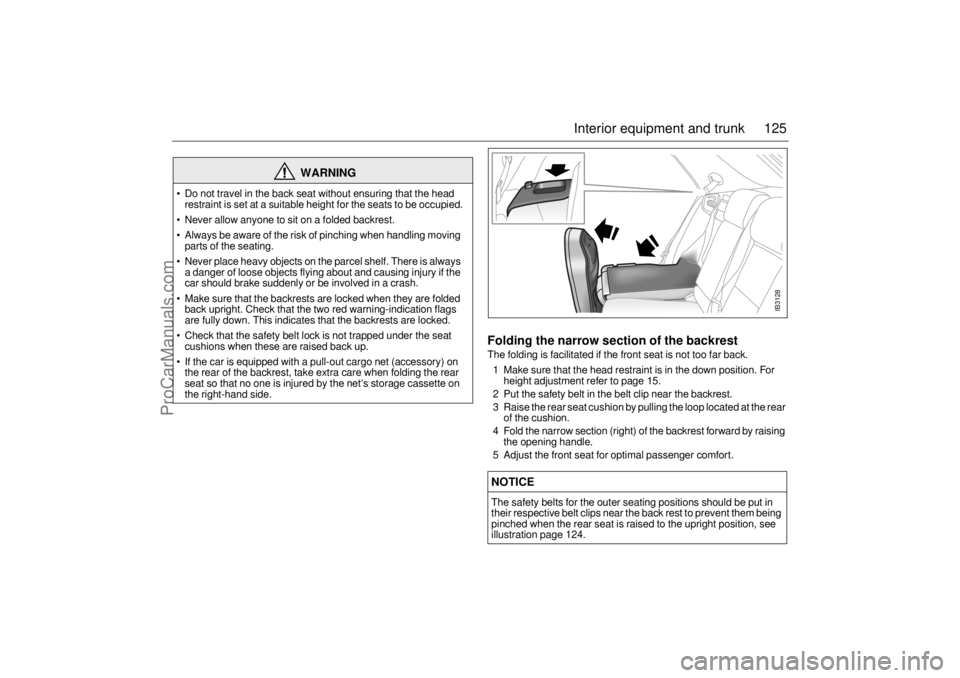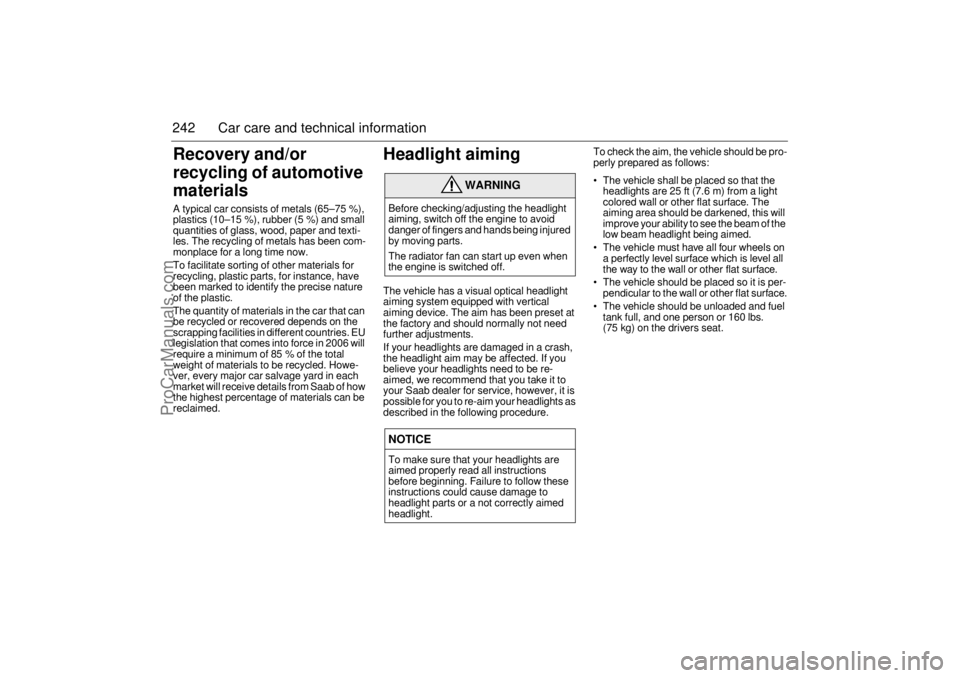seat adjustment SAAB 9-5 2005 Owners Manual
[x] Cancel search | Manufacturer: SAAB, Model Year: 2005, Model line: 9-5, Model: SAAB 9-5 2005Pages: 276, PDF Size: 16.72 MB
Page 7 of 276

5
Interior
IB3150
Rearview mirrors ______________ 107
Door mirrors __________________ 107
Sun visors ___________________ 117
Safety belts ____________ 16
Airbag_________________ 28
Child safety ____________ 21
Child safety locks ________ 41
Safety belts, maintenance _ 235Glove compartment ______ 118Manual transmission _____ 142
Automatic transmission ___ 143
Electric windows ______________ 113
Ignition switch ________________ 132
Starting the engine ____________ 133
Engine Break-In Period _________ 142
Driving in hot weather __________ 160
Driving in cold weather _________ 159
Parking _____________________ 179
Steering wheel adjustment _ 106
Airbag _________________ 28
Power steering fluid _______ 191
Steering-wheel controls ___ 100
Sentronic, manual mode ___ 148Seats __________________ 12
Electric heating, front seats (if
equipped) ______________ 15
Ventilated front seats______ 14
Safety belts _____________ 16
Child safety _____________ 21
Folding the rear seat,
9-5 Sedan _____________ 121
Folding the rear seat,
9-5 SportWagon_________ 124
Upholstery and trim _______ 236
Side airbags ____________ 32
Interior lighting ________________ 116
Sunroof _____________________ 114
Dome light, front ______________ 209
ProCarManuals.com
Page 14 of 276

12 SafetySeats Both front seats are electrically operated.
On certain models the driver´s seat is equip-
ped with a memory function.
To facilitate getting into the car, both seats
can be adjusted when either of the front
doors is open.
For safety reasons, if the door is closed, the
seat can only be adjusted when the ignition
is ON.
Note, however, that both seats can be
adjusted for 30 seconds after both doors
have been closed. The following seat adjustments can be
made to achieve a comfortable driving
position:
height
legroom
backrest rake angle
lumbar support (driver´s seat)
head-restraint height
We recommend that adjustments to the
driver’s seat be performed in the following
order:
1height
2 legroom
3 seat tilt angle
4 backrest rake angle
Lastly, adjust the steering wheel (see
page 106).
Side airbags(see page 32).Head restraint(see page 15).
HeightTo raise the seat, lift the lower control
straight up.
To lower the seat, press the lower control
down.
The same control can be used to adjust the
height of the front and rear edges of the seat
independently.
WARNING
The seats are actuated by powerful
motors. Bear this in mind when adjusting
the seat, and make sure that nothing gets
caught and damaged. Ensure that not-
hing can be trapped when adjusting the
seat.
Bear in mind that children can be injured
if they play with the electrically-operated
seats.
Always remove the ignition key when you
leave the car. This prevents personal
injury caused by the electrically adjusta-
ble seats, for example, due to children
playing.
WARNING
Never adjust the driver’s seat except
when the car is stationary.
IB3225
ProCarManuals.com
Page 18 of 276

16 SafetyRear-seat head restraints9-5 Sedan: The rear head restraints have
three adjustment positions for passenger
comfort.
They can also be folded down to increase
the driver’s rearward vision when the seat is
unoccupied.
9-5 SportWagon: The height of the rear
head restraints can be adjusted by depres-
sing the catch on the left-hand collar in the
same way as the front head restraints.
See page 15 for adjustment procedure.
Safety belts Three-point inertia-reel safety belts are pro-
vided for all seats.
The results of studies show that it is equally
important to wear safety belts in the rear
seat as in the front seats.
Bear in mind that in certain states/provinces
it is a legal requirement for all occupants of
the car to wear a safety belt.
Safety belt reminderWhen the ignition is switched on, the
”FASTEN BELTS” reminder will light up until
the driver fastens the safety belt. In addition
an audible signal sounds for 6 seconds, or
until the driver fastens his belt. Safety belt pretensionersThe belts of the front seats are fitted with
automatic pretensioners and force limiters.
These are activated in the event of a severe
frontal or rear-end crash and a side-on col-
lision, provided that the safety belts are
being worn.
The pretensioners serve to reduce the for-
ward movement of the body by tensioning
the belt. The force limiters reduce belt loads
on the body by "loosening" the safety belt to
absorb the body’s kinetic energy as gradu-
ally as possible.
WARNING
Buckle up and adjust your safety belt
before driving off so that you can pay
full attention to the traffic.
Safety belts must be worn at all times
by all car occupants.
Child safety, see page 21.
Check that the locking tongue is pro-
perly locked in the belt lock.
In the event of a crash, the rear-seat
passengers not wearing a seatbelt will
be thrown forward against the
front-seat backrests. The stresses
imposed on the front seat passengers
and belts are multiplied and can result
in needless injury or even death for all
car occupants.
IB460
IB409
FASTEN BELTS
ProCarManuals.com
Page 20 of 276

18 SafetyFront safety belts Fasten the belt by pulling the belt and inser-
ting the tongue in the buckle. Check that it is
securely fastened.
Grasp the shoulder belt close to the buckle
and pull the belt towards the shoulder to
tighten the lap belt part.
Then grip the belt at the shoulder, pull it out
and, without letting go, allow the slack to be
taken up by the reel. Make sure that the belt
is well in on the shoulder.
Because the lower belt-anchorage points
are on the seat, the belt buckle follows the
movement of the seat during seat adjust-
ment.To release the belt, press the red button on
the belt buckle, as illustrated.
See page 235 for the checking of belt func-
tion, cleaning, etc.
Belt height adjustmentThe front safety belts and the outside belts
in the rear (9-5 Sedan) are equipped with
automatic height adjustment.
After fastening the belt, grasp it at chest
height, pull it out and, without letting go,
allow the slack to be taken up by the reel.
Make sure that the belt is well in on the
shoulder.
IB411
To fasten the belt
IB412
Press the red button to release the belt
ProCarManuals.com
Page 126 of 276

124 Interior equipment and trunkFolding the rear seat, 9-5 SportWagonBoth the narrow and wide sections of the rear seat can be folded
separately. Folding is facilitated if the front seats are not located too
far back. The wide section cannot be folded separately if a cargo net
(accessory) is mounted on the rear of the backrest.
1 Make sure that the head restraint is in the down position. For
height adjustment refer to page 15.
2 Put the safety belts for the outer seat places in their respective
belt clips, which are located near the backrest (see illustration).
3 Raise the rear seat cushions by pulling the loop located between
the cushion and the backrest.
4 Fold the narrow section (right) of the backrest forward by raising
the opening handle on the right-hand side.
5 Fold the wide section of the backrest forward in the
corresponding manner.
6 Adjust the front seats for optimal driving/passenger comfort.
Alternative location of the parcel shelf if this is removed:
Folded up on the floor at the rear of the luggage compartment.
On edge behind the backrests of the front seats.NOTICEThe safety belts for the outer seating positions should be put in
their respective belt clips near the backrest to prevent them from
being pinched when the rear seat is raised to the upright position.
IB1211
IB3127
Safety belt loca-
ted in its belt clip
ProCarManuals.com
Page 127 of 276

125 Interior equipment and trunk
Folding the narrow section of the backrestThe folding is facilitated if the front seat is not too far back.
1 Make sure that the head restraint is in the down position. For
height adjustment refer to page 15.
2 Put the safety belt in the belt clip near the backrest.
3 Raise the rear seat cushion by pulling the loop located at the rear
of the cushion.
4 Fold the narrow section (right) of the backrest forward by raising
the opening handle.
5 Adjust the front seat for optimal passenger comfort.
WARNING
Do not travel in the back seat without ensuring that the head
restraint is set at a suitable height for the seats to be occupied.
Never allow anyone to sit on a folded backrest.
Always be aware of the risk of pinching when handling moving
parts of the seating.
Never place heavy objects on the parcel shelf. There is always
a danger of loose objects flying about and causing injury if the
car should brake suddenly or be involved in a crash.
Make sure that the backrests are locked when they are folded
back upright. Check that the two red warning-indication flags
are fully down. This indicates that the backrests are locked.
Check that the safety belt lock is not trapped under the seat
cushions when these are raised back up.
If the car is equipped with a pull-out cargo net (accessory) on
the rear of the backrest, take extra care when folding the rear
seat so that no one is injured by the net’s storage cassette on
the right-hand side.
NOTICEThe safety belts for the outer seating positions should be put in
their respective belt clips near the back rest to prevent them being
pinched when the rear seat is raised to the upright position, see
illustration page 124.
IB3128
ProCarManuals.com
Page 215 of 276

213 Car care and technical information
Fuse panel in instrument panel
# Amp Function A 30 Trailer lights
B 10 Automatic transmission
C 7.5 Electric door mirrors; DICE: manual beam length
adjustment
115Brake lights
2 15 Reversing lights
3 10 Parking lights and taillights, left
4 10 Parking lights and taillights, right
5 7.5 DICE / TWICE
6 30 Electric windows, right; trailer charging
6B 7.5 Brake lights, trailer
7 10 Engine injectors
8 15 Trunk lighting; trunk lock; door lighting, circulation
pump; parking assistant; SID
9 15 Audio System; CD changer
10 15 Heating, rear seat; sunroof, remote control receiver
11 30 Electrically adjusted passenger seat
12 7.5 Automatic transmission
13 20 Audio System, amplifier
14 30 Ignition system, engine
15 20 Fuel pump
16 20 DICE (direction indicators)
16B – OnStar (if equipped)
17 20 Engine-management system; main instrument;
DICE/TWICE
18 40 Door-mirror heating; rear-window heating
19 10 OnStar; Telematics (if equipped)
20 15 ACC; interior lighting; rear fog light; high beam flasher
21 10 Audio System; rear-view mirror; load angle sensor
(cars with xenon); navigation (accessory); Cruise
Control
22 40 Interior fan
23 15 Central locking; navigation (accessory); door mirror
memory
24 – –
25 30 Electrically adjustable driver’s seat
26 7,5 Driver seat memory; mirrors memory; sunroof; par-
king assistant; seatbelt reminder
IB2439
BC123456 A
14
121110987
13
6B
1516
2324
222120191817
16B25262728293031
3635343332
393837
ProCarManuals.com
Page 244 of 276

242 Car care and technical informationRecovery and/or
recycling of automotive
materialsA typical car consists of metals (65–75 %),
plastics (10–15 %), rubber (5 %) and small
quantities of glass, wood, paper and texti-
les. The recycling of metals has been com-
monplace for a long time now.
To facilitate sorting of other materials for
recycling, plastic parts, for instance, have
been marked to identify the precise nature
of the plastic.
The quantity of materials in the car that can
be recycled or recovered depends on the
scrapping facilities in different countries. EU
legislation that comes into force in 2006 will
require a minimum of 85 % of the total
weight of materials to be recycled. Howe-
ver, every major car salvage yard in each
market will receive details from Saab of how
the highest percentage of materials can be
reclaimed.
Headlight aimingThe vehicle has a visual optical headlight
aiming system equipped with vertical
aiming device. The aim has been preset at
the factory and should normally not need
further adjustments.
If your headlights are damaged in a crash,
the headlight aim may be affected. If you
believe your headlights need to be re-
aimed, we recommend that you take it to
your Saab dealer for service, however, it is
possible for you to re-aim your headlights as
described in the following procedure.To check the aim, the vehicle should be pro-
perly prepared as follows:
The vehicle shall be placed so that the
headlights are 25 ft (7.6 m) from a light
colored wall or other flat surface. The
aiming area should be darkened, this will
improve your ability to see the beam of the
low beam headlight being aimed.
The vehicle must have all four wheels on
a perfectly level surface which is level all
the way to the wall or other flat surface.
The vehicle should be placed so it is per-
pendicular to the wall or other flat surface.
The vehicle should be unloaded and fuel
tank full, and one person or 160 lbs.
(75 kg) on the drivers seat.
WARNING
Before checking/adjusting the headlight
aiming, switch off the engine to avoid
danger of fingers and hands being injured
by moving parts.
The radiator fan can start up even when
the engine is switched off.NOTICETo make sure that your headlights are
aimed properly read all instructions
before beginning. Failure to follow these
instructions could cause damage to
headlight parts or a not correctly aimed
headlight.
ProCarManuals.com
Page 266 of 276

264 SpecificationsSeveral of the systems in your
Saab car can be adjusted to
better fit your individual needsSome functions are governed by legal
requirements and cannot therefore be
reprogrammed.
Consult an authorized Saab dealer for
further information.Car alarm/central locking system: The number of blinks when locking/
unlocking.
Automatic locking of the trunk when the
car is driven, 1 to 8 mph (2–14 km/h), YES
or NO.
Preclude the unlocking of the trunk while
the car is driven, YES or NO.
Automatic locking of the trunk after
1 second–4 minutes if it has not been
opened, YES or NO.
Automatic locking of the trunk when it is
closed, YES or NO.
Automatic locking of all doors when the
car is driven above 7.5 mph (12 km/h),
YES or NO.
Saab Information Display: Outdoor temperature display can be
adjusted.Miscellaneous: Select the on-time for heated rear seat.
Additional sweep of the wipers after
windshield washer function (ON or OFF).
Courtesy Headlight Feature on-time can
vary from 20 to 50 seconds.
Night panel illumination deactivation
speed for the speedometer can be adjus-
ted.
Following adjustments can be
done by the driver:Automatic Climate Control (ACC):To alter the preprogrammed ”AUTO” start
up mode with your own preferences you can
manually select the desired settings for:
Temperature.
Fan speed.
Air distribution.
See ”Programming I” on page 79 and ”Pro-
gramming II” on page 80.Saab 9-5 Audio System (see page 99): Maximum starting volume (when the
radio is switched on).
Telephone volume (if the car is equipped
with a phone connected to the audio
system).
Speed dependent volume (volume
increases or decreases with vehicle
speed).
Loudness.Daytime Running Lights:To disable, turn off the ignition and pull out
fuse 35, see page 214.
ProCarManuals.com
Page 267 of 276

265 Index
IndexAA/C system, fault diagnosis
_______ 235
A/C system, maintenance
_________ 234
ABS brakes
____________________ 152
ACC
__________________________ 73
ACC functions
___________________ 76
ACC, automatic climate control
_____ 73
ACC, calibration
_________________ 81
ACC, condensation _______________ 82
ACC, programming _______________ 79
ACC, useful tips
_________________ 81
Adjusting the steering wheel
_______ 106
Adjustment, seats
________________ 12
Air conditioning (A/C), fault diagnosis
and maintenance ______________ 234
Air distribution, ACC ______________ 78
Airbag
_________________________ 28
Alarm _________________________ 44
Alarm functions
__________________ 47
Alarm signals
________________ 44
, 47
Alternator
_____________________ 194
Alternator drive belt
__________ 194
, 257
Alternator rating
________________ 257
Anticorrosion treatment
___________ 240
Antidazzle rear-view mirror
________ 111
Ashtrays
______________________ 117
Audio System
___________________ 83Audio System, quick guide
_________ 85
Autochecking of lights on starting
____ 58
Auto-dimming rear-view mirror with
garage door opener
____________ 108
Automatic climate control (ACC)
_____ 73
Automatic transmission, technical
data
_________________________ 258
Aviod theft, tip
__________________ 179
BBattery
________________________ 192
Battery charging/replacing
________ 193
Battery, boost starting
____________ 174
Before a long journey ____________ 241
Before towing a camper or trailer
___ 164
Belt guide
______________________ 16
Boost starting using jump leads
____ 174
Brake and clutch fluid
____________ 189
Brake-fluid reservoir
_____________ 189
Brakes, technical data ____________ 259
Bulbs, changing
________________ 197
Bulbs, table of
__________________ 210
Buying new tires ________________ 219
CCD changer
_____________________ 95
CD player
______________________ 93CHECK messages
_______________ 64
CHECKING
_____________________ 64
Calibration, ACC
_________________ 81
Cancelling the programmed settings
__ 79
Car alarm
_______________________ 44
Car care _______________________ 181
Cargo net, 9-5 SportWagon
_______ 128
Carpeting, care of
_______________ 236
Cassette player
__________________ 90
Catalytic converter, important
considerations _________________ 137
Central locking ___________________ 38
Change language in SID
___________ 66
Change of address notification
_____ 248
Changing a wheel
_______________ 231
Changing bulbs
_________________ 197
Changing wiper blades
___________ 195
Charger/Jump starting ____________ 176
Charging the battery/Jump starting
__ 176
Chassis number
________________ 262
Chassis number, key to
___________ 263
Checks before towing a camper or
trailer
________________________ 164
Child safety
_____________________ 21
Child safety locks, rear doors
_______ 41
Cleaning, engine bay
_____________ 238
Clock
_______________________ 65
, 66
Color code, body
________________ 262
Color code, trim _________________ 262
Compact spare wheel
____________ 230
Compass
______________________ 112
Condensation, ACC
_______________ 82
ProCarManuals.com